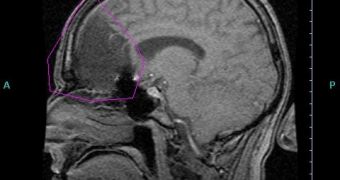Scientists part of a multi-institutional collaboration led by William Weiss, MD, PhD, a neuro-oncologist at the University of California at San Francisco, found the type of cell that is at the origin of brain tumors called oligodendrogliomas (a type of glioma) – the most common type of malignant brain tumors.
The researchers discovered that the tumor originated in and spread through cells called glial progenitor cells, that are often called the 'daughter' cells of stem cells.
Today, part of the stem cells research is focusing on the role that rogue cells play in causing cancer, so in order for scientists to create new ways of treating brain tumors, is very important to know which ones are part of the process – stem cells or progenitor cells.
So the study focused on oligodendrogliomas, a type of tumor that resembles other brain tumors, with symptoms like headaches, seizures and cognitive changes.
Oligodendrogliomas are less deadly and invasive than most other gliomas, at first, but ultimately, the majority of patients die from the disease.
All tumors were treated with a combination of surgery, radiation and chemotherapy, because treatments like surgery usually slow or stop the tumor initially, but it generally returns, in most cases in a much more aggressive form than it was at first.
Steven Goldman, MD, PhD, a University of Rochester Medical Center neurologist who was part of the study team, said that “in many ways progenitor cells are controlled by completely different signaling pathways than true stem cells.
“Knowing which type of cell is involved gives us a clear look at what drug approaches might be useful to try to stop these tumors.
“Comparing normal progenitor cells to progenitors that give rise to tumors gives us a roadmap to follow as we try to develop new treatments.”
Four years earlier, Goldman and his team identified a progenitor cell as the origin of a brain tumor called neurocytoma, and other separate studies found that brain tumors called medulloblastomas and ependymomas also arise from progenitor cells.
Goldman, who is chair of the Department of Neurology and head of the laboratory where much of the genetic analysis for the study was done, said that “right now, when treating most brain tumor patients, one size fits all.
“As with many forms of cancer, today's treatments of glioma are not very specific – they take aim at all dividing cells.
“Unfortunately, with brain tumors, it's often the most aggressive, malignant cells that survive chemotherapy and radiation, and they take over the tumor and ultimately kill the patient.
To be able to identify better treatments for this kind of tumor, the type of the cancer source cell is crucial, but despite a lot of clinical experience with brain cancer no one found it before.
So the team used a common brain tumor drug called temozolomide, and tested several types of cells from both human and mouse tumors.
The results showed that the drug was effective against oligodendroglioma cells and normal glial progenitor cells, and much less effective against brain stem cells or other brain tumors called astrocytomas.
So this work also confirms that at the origin of some brain tumors, stand progenitor cells and not stem cells.

 14 DAY TRIAL //
14 DAY TRIAL //